| DRAGONS |
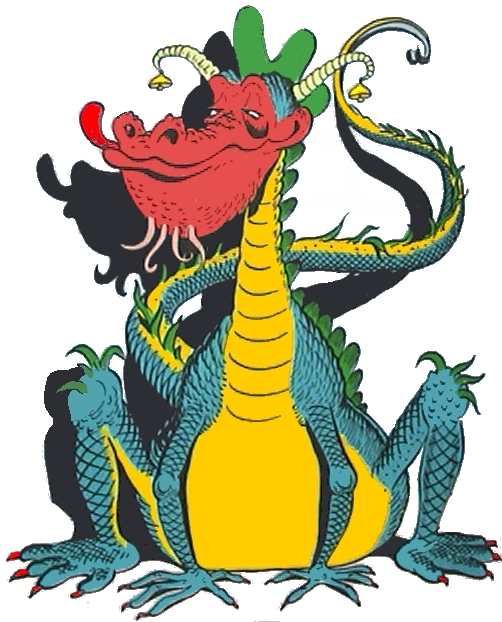
U$12
The Golden Fleecing |
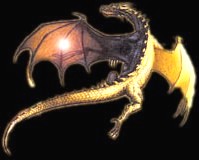
Good or bad? |
Dragons are a strange sort of
mythical creatures. In the Western hemisphere
they are feared for their evil nature, but in the
Eastern world they are worshipped for their luck-bringing
qualities. Usually they seem to be a combination
of several undefinable animals, and in many cases
they also have the ability to fly. But all
dragons with just an iota of self respect have a
special trademark - they are capable of breathing
fire.
This was also the case with the stunning dragon
Barks introduced in U$12 The Golden
Fleecing. And he chose to make it partly
good and partly evil just to accommodate the
readers. But Barks' fat dragon did not have the
gift of flying. |
|
| MYTHOLOGICAL
WORLDS |
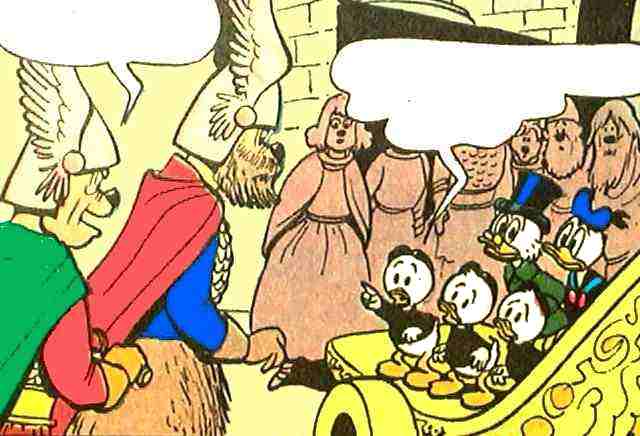
U$34
Mythic Mystery |

Olympus - HQ
of the Greek Gods |
| Besides his interest in legends
Barks was also very interested in mythology. From
time to time he looked to the tales of Nordic,
Roman and Greek mythology in order to get ideas
for his stories. Examples include U$40
Oddball Odyssey where he lets Magica de
Spell play the role of Greek sorceress Circe, and
U$34 Mythic Mystery in which he
manages to combine the Gods from all three
mythological worlds mentioned above. And in U$10
The Fabulous Philosophers' Stone he
surpasses himself by allowing the main story -
about the medieval Philosophers' Stone - to go in
several mythological directions such as the story
of King Midas and the fabled Labyrinth of Crete. |
|
| ZOMBIES |
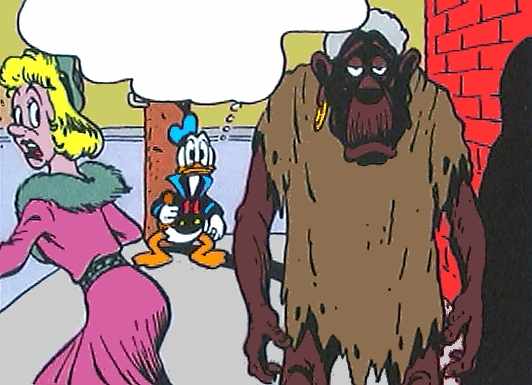
FC0238 Voodoo Hoodoo |
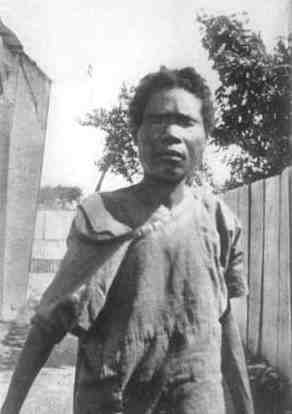
Felicia Felix-Mentor |
In its basic form a zombie is a dead
person who is brought back to life through the
means of Voodoo magic. It all originates from
Africa but is nowadays more commonly known to
take place in Haiti where thousands of people are
thought to be zombies. One example is Felicia
Felix-Mentor of Haiti, who died and was buried in
1907, but who was found wandering the countryside
in 1937. A photograph was taken of her.
Barks was triggered by a Bela Lugosi movie called
White Zombie and a thrilling painting by Joe
Little showing a humanlike zombie with torn
clothes. This inspired him to build a story
around such a creature. However, it turned out to
be somewhat of a cuddly monster in the comic
book, because Barks had no intention of imitating
the horrid monsters known from the EC comics. |
|
| UNICORNS |
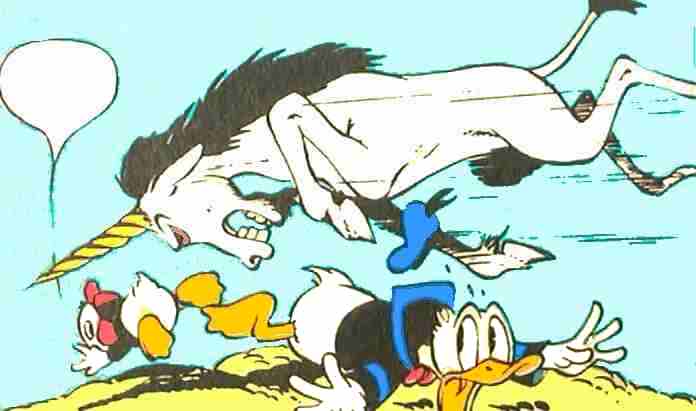
FC0263
Trail of the Unicorn |
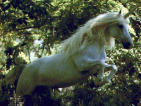
The elusive
creature |
Horses have always been popular
creatures in myths and legends. Just think of the
centaur and the pegasus. And the unicorn. This
animal has been known for thousands of years.
Mentioned in the bible, in mythology, and by
great philosophers. A unicorn is generally known
as a white mare with one spiralled horn growing
from the center of its head. It is generally
known for having magical powers, usually held
within the horn. For this power it is sought by
man. However, it is very hard indeed to catch a
unicorn. They are very smart and quick, and they
have their magic to help them out.
Barks chose to make a story of the fabled horse (FC0263
Trail of the Unicorn) although he never
gave it magical powers. On the other hand he
revealed that the creature can be found in the
Himalayas. |
|
| ATLANTIS |
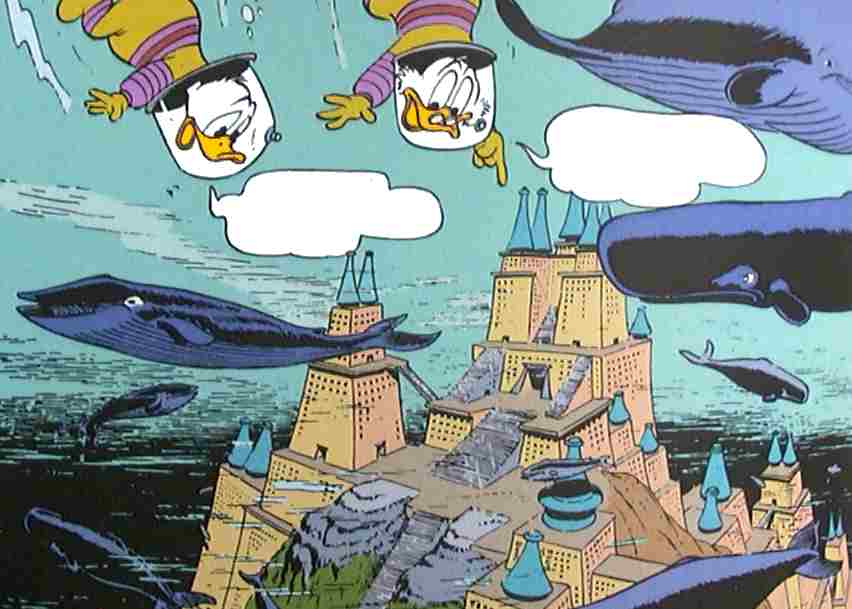
U$05 (Secret of Atlantis) |
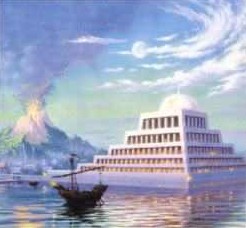
As it might
have looked... |
The story of fabled sunken Atlantis
begins quite literally with two of the Greek
philosopher Plato's dialogues, Timaeus and
Critias. These accounts are the only known
written records that refer specifically to a lost
civilization by the name of Atlantis. Many people
believe the tale to be complete fiction, the
creation of a philosopher's imagination used to
illustrate an argument. Others believe that the
story was inspired by catastrophic events which
may have destroyed the old Minoan civilization on
Crete and Thera.
Barks drew his story at a time when the myth and
the whereabouts of the sunken Atlantis was - once
again - being debated and Barks decided to
venture his version of the elusive place which he
placed in the Atlantic Ocean. |
|
| LOST
TREASURES |
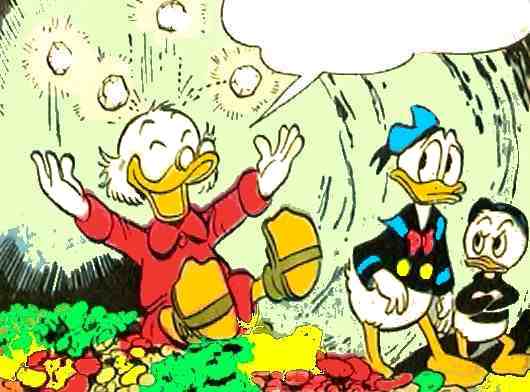
U$19 The Mines of King Solomon |
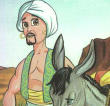
Ali Baba |
One of the more intriguing mysteries
that people have pondered on for centuries is the
whereabout of hidden treasures. The theme seems
to appeal to us and countless searches and
expeditions have been launched in an effort to
find fabled treasures buried by kings, pirates
and war criminals. And always with extremely poor
results.
Barks also did his share of speculation. But with
the crucial difference that his ducks actually
found the treasures they set out to find. In U$19
The Mines of King Solomon they ended up
in the king's fabulous mines, in U$55
McDuck of Arabia they found the lost
mine of the Queen of Sheba, and in U$37
Cave of Ali Baba they reached the
hideout of the legendary robber. |
|
| LUCKBRINGERS |
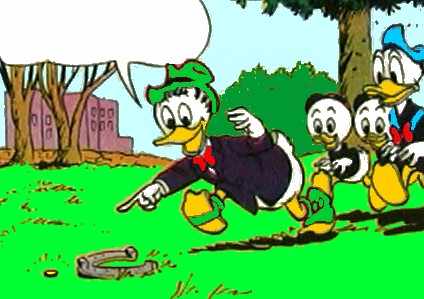
WDCS163 |

Rabbit's foot |
The human race has always felt the
need for special things which they can use for
good luck charms. A rabbit's foot is one of
humanity's absolutely oldest superstitious icons,
having been used since before 600BC. Because
rabbits are prolific breeders, they are seen as
symbols of fertility and they are thought to
provide good luck, good crops, many children, and
prosperity. Also, the foot is considered a
powerful charm against evil - with a possible
exception for the rabbit itself!
Barks used this lucky symbol in several stories (usually
carried by Gladstone Gander) but he also used
four-leaf clovers, fortune cookies, and
horseshoes. |
|
| MERMAIDS |
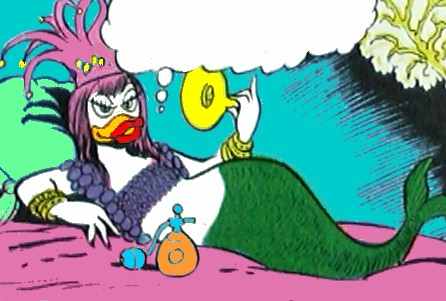
U$68
Hall of the Mermaid Queen |
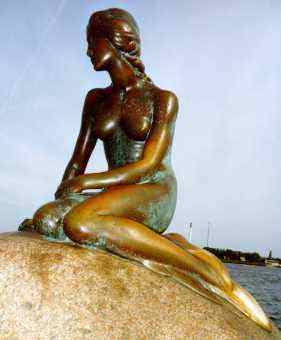
The Little
Mermaid, Denmark |
| Stories of mermaids have been told
for centuries - be it in the form of folklores,
legends or fairytales - and they have always had
a tremendous appeal on the human mind. There is
no clear definition of what exactly a mermaid
looks like but she (the male version is called a
merman) is usually depicted with a fishtail. So
is the one Barks chose for his story U$68
Hall of the Mermaid Queen. The most
famous story tends to be from the pen of Danish
Storyteller Hans Christian Andersen who wrote the
fairytale The Little Mermaid about a woman who
fell hopelessly in love with a merman and
consequently decided to live by his side under
the sea. |
|
| LEGENDARY
PEOPLE |
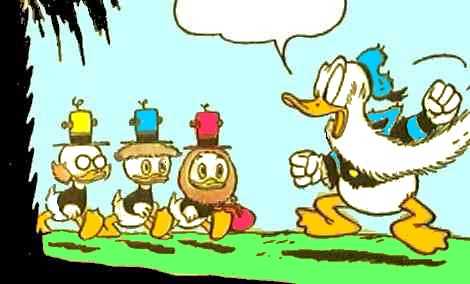
WDCS112 |
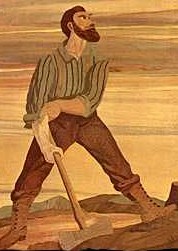
Paul Bunyan |
History is filled with tales of
ordinary - and mostly imaginary - people who have
done extreme deeds. These people are usually
unknown to the public but after their usually
spectacular feats people continue to think about
them.
Barks used several of these stories as background
material in his comics. Among them are Paul
Bunyan (U$28 The 'Paul Bunyan' Machine) who
supposedly was a giant lumberjack whose
'legend' was created in logging camps by
lumberjacks who gathered around the woodstoves on
cold winter evenings. Another one was about a Dutch immigrant to the USA,
Rip van Winkle (WDCS112),
and his twenty-year
nap in the Catskill Mountains before waking up to
a much-changed world. Barks was also inspired by
a story named The Hole in the Dike (WDCS288
Hero of the Dike) which describes a
Dutch boy who saves a town by sticking his finger
in the hole of a flooded dike. |
|
| YETIS |
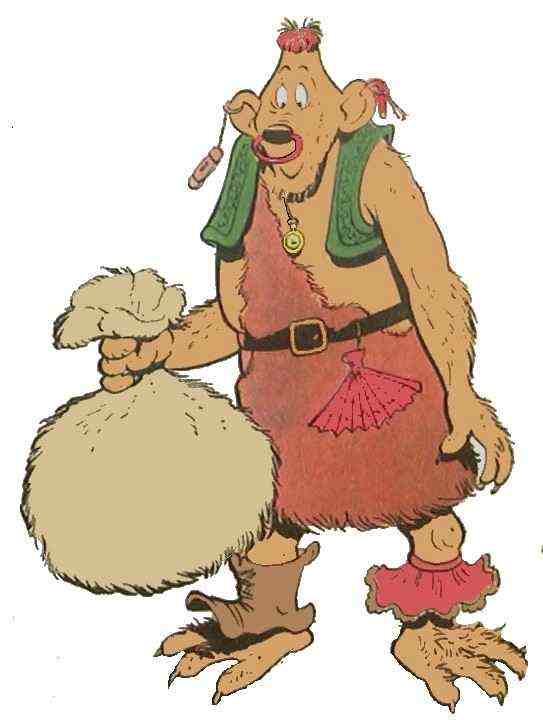
U$14
The Lost Crown of Genghis Khan |

The American
mystery - Bigfoot |
Tales of highly elusive manlike
creatures are told in many parts of the world.
They all seem to have been spotted by thousands
of people, but none of the creatures have ever
been satisfactorily documented. Still they play a
powerful role in our minds. One example is the
Yeti which has mysteriously lived in the
Himalayas for many years. Known as 'the rock
living animal' ('Yah' means rock and 'teh' means
animal) in Sherpa, and popularly known as 'The
Abominable Snowman" in the West, the
sightings of Yetis have been reported since the
late 1800s.
When Barks made U$14 The Lost Crown of
Genghis Khan - which takes place in the
Himalayas - it was of course inevitable that he
should have a go at the yeti. And of course he
would have a radically different approach to the
subject; his creature was quite lovable! |
|
| THE
FOUNTAIN OF YOUTH |
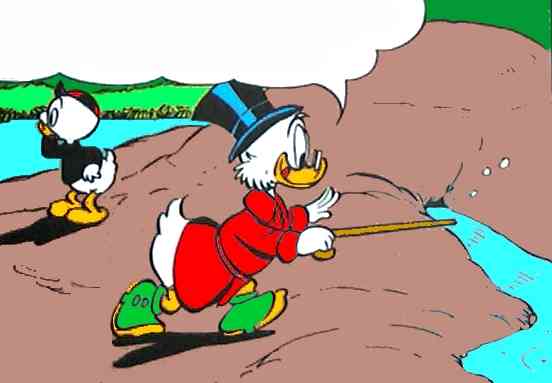
U$32 That's No Fable! |

Ponce de Leon |
In 1493 the Spanish conquistador
Ponce de Leon came to the Americas. After he had
discovered Puerto Rico tradition tells that the
natives told him of a land to the north with a
spring where waters had such miraculous curative
powers that any old person who bathed in them
would regain his youth. de Leon went on to search
for the fabled Fountain of Youth. He found
Florida which he explored meticulously for 8
years without finding any trace of the elusive
waters.
Barks was inspired by the persistent myth and he
managed to dream up a story which even contained
a couple of the original conquistadors.
Furthermore, he 'revealed' to us that the
fountain is not in existence anymore. |
|
| LOST
WORLDS |
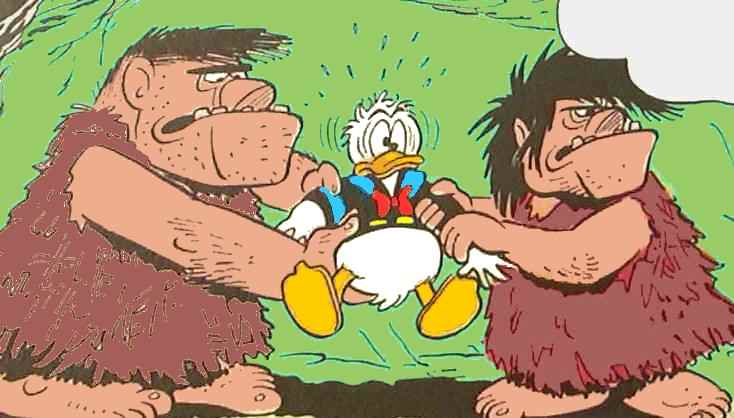
WDCS246 |
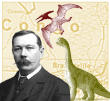
Arthur Conan
Doyle |
Mankind has always been fascinated
by the very idea of lost worlds hidden somewhere
on Earth. They normally contain either ferocious
tribes or strange animals which time has left
behind. One of the most famous contributors to
the myth is the British Sherlock Holmes author
Arthur Conan Doyle who wrote a novel called The
Lost World in 1912.
Barks also made a few contributions to the myth:
In WDCS058 and WDCS246 the
ducks encounter primitive tribes at the bottom of
the American Grand Canyon, and in DD54
Forbidden Valley they meet many
dinosaurs during a trip to Africa. |
|
| GHOSTS |
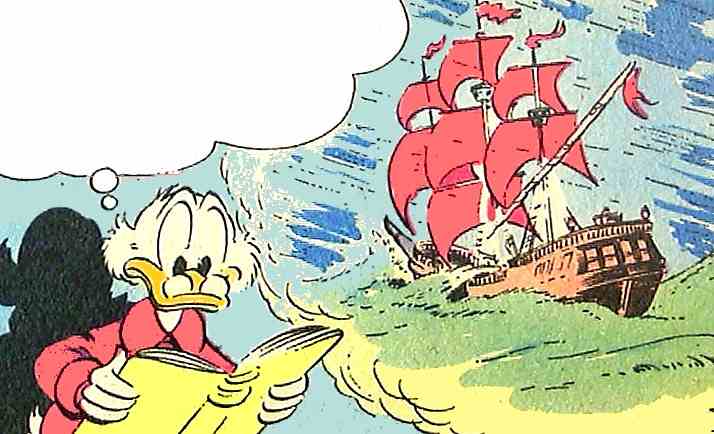
U$25
The Flying Dutchman |
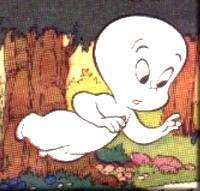
Casper, The
Friendly Ghost |
The term Ghost covers a lot of
ground - from innocent ones such as the cartoon
character Casper to the much more sinister,
haunting ones in the shape of deceased people.
And Barks produced stories in all categories.
Here are examples of the two extremes:
In U$56 Mystery of the Ghost Town
Railroad Barks tells amusingly about
crows dressed up as ghosts wearing white sheets.
He got the initial idea about a ghost infested
hotel on a car trip when he and his wife
passed a certain hotel in Nevada which was said
to be haunted.
Barks used a well-known myth when he made U$25 The Flying
Dutchman. Through time many authors have
written about the socalled Flying Dutchman, the
ship that was cursed to sail the high seas
forever, because its Dutch captain had made a
blasphemous remark. And Barks gladly joined the
party. |
|
| FLYING
SAUCERS |
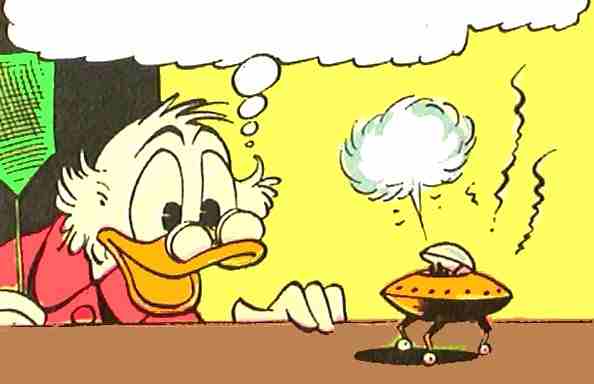
U$65
Micro-Ducks from Outer Space |

Friend or Foe
- or Fake |
Is there life out there in Space?
The question has been asked for centuries and the
possible affirmative answer has intrigued people
ever since. The debate really took off in 1947
when an American pilot, Kenneth Arnold, spotted 9
silver disc-shaped flying objects which to his
mind clearly were not of earthly origin. The
phenomenon was named Flying Saucers and the craze
was on. Since then countless UFOs - today's
common name for the airships - have been sighted
and little green men seem to pop up every other
minute.
Barks made his contribution to the craze in 1966
when U$65 Micro-Ducks from Outer Space was
published. He incorporated the famed flying
saucer and the little green men, and he also
managed to add his own twist to the story; the
cigar-shaped airship was in the size of - a cigar... |
|
| SEA
SERPENTS |
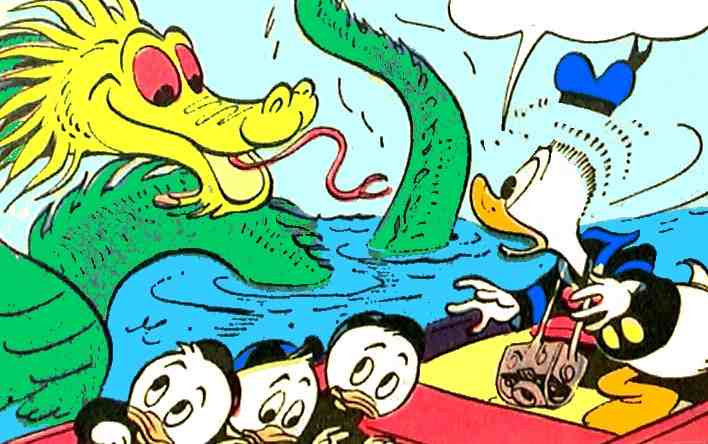
WDCS237
Mystery of the Loch |
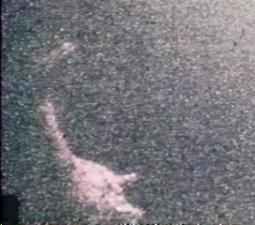
Nessie from
Loch Ness in Scotland |
Sea serpents are perhaps the most
sought-after legendary creatures in the world.
Probably because they appeal to us in a number of
different ways: they touch our curiousity, they
are highly elusive, and they are generally feared.
Barks quickly realized the vast potential in such
secretive animals and he made no less than 4
stories in which they played leading parts (some
of them were manmade, however, just as one might
suspect from today's discoveries and poor
photographs): FC0108 The Terror of the
River, FC0318 No Such Varmint,
WDCS237 Mystery of the Loch, and
WDCS292 Instant Hercules. |
|
| POTS
OF GOLD |
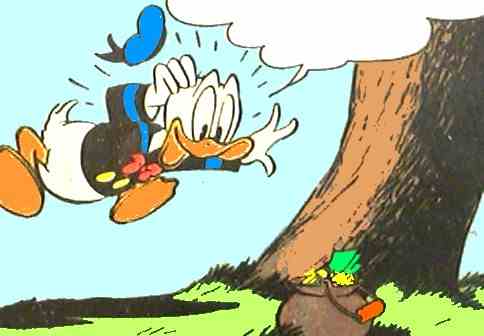
WDCS155 |

Where does it
end? |
| Mankind always seem to have regarded
a rainbow as good news. Maybe the myth derives
from the Bible's description of Noah's Ark, in
which God put a rainbow on the sky after the
great flood. Later on, the myth also told that if
you dig at the end of a rainbow, you will be sure
to find a pot of gold. How this extended version
came about is lost in history's vail but it is
still a popular belief. Quite strange, really, as
no one can ever find the end of a rainbow. Except
in WDCS155 in which Barks spins
a yarn over the theme of mortality and death. The
ducks manage to find three pots of gold at the
end of the same rainbow. |
|

